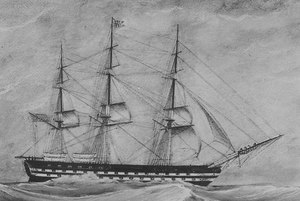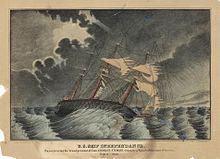USS Independence (1814)

| |
| History | |
|---|---|
| Name | USS Independence |
| Namesake | Declaration of Independence |
| Builder | Boston Navy Yard |
| Launched | 22 June 1814 |
| Decommissioned | 1822 |
| Refit | Razeed, 1836 |
| Recommissioned | 26 March 1837 |
| Decommissioned | 3 November 1912 |
| Stricken | 3 September 1913 |
| Fate | Scrapped 1915 |
| General characteristics | |
| Type | Ship of the line |
| Tonnage | 2243 |
| Length | 190 ft 9 in (58.14 m) |
| Beam | 54 ft 7 in (16.64 m) |
| Draft | 21 ft 3 in (6.48 m) |
| Propulsion | Sail |
| Complement | 790 officers and enlisted |
| Armament | 90 × 32-pounder (15 kg) guns |
USS Independence was a wooden-hulled, three-masted ship, originally a ship of the line and the first to be commissioned by the United States Navy. Originally a 90-gun ship, in 1836 she was cut down by one deck and re-rated as a 54-gun frigate.
Service history
Mediterranean Fleet, 1814–1822

Launched on 22 June 1814 in the
Peace had been enforced by a squadron under
Refit 1836
Independence remained in ordinary at Boston until 1836 when she was razeed (cut down to one covered fighting deck with poop and forecastle). She was rated down to 54 guns as her configuration gave way to that of a very large frigate. She proved to be one of the fastest and most powerful "frigates" of the Navy.
Russia, South America, Home Squadron, 1837–1845

Independence recommissioned on 26 March 1837 and sailed from Boston on 20 May 1837 as flagship of Commodore
Having received marked social courtesies from the Russian government, Independence departed Kronstadt on 13 August 1837 for Rio de Janeiro, where she became flagship of the Brazil Squadron to guard American commerce along the eastern seaboard of South America. This duty continued into the spring of 1839 when Commodore Nicholson attempted mediation to end the war between France and Argentina. He reported 22 April 1839 that:
"I volunteered, as I conceived it a duty I owed to my Country, as well as to all Neutrals, to endeavor to get peace restored that commerce should be allowed to take its usual course. In accordance of the feelings of humanity at least, I hope my endeavors will be approved by the Department . . . I see no probable termination of this War and Blockade which is so injurious to the Commerce of all Neutrals ... "
Independence returned north to
Mexican War, 1846–1849
She recommissioned on 4 August 1846, and the nation was already at war with Mexico as she departed Boston 29 August 1846 for the coast of California. She entered Monterey Bay on 22 January 1847 and became the flagship of Commodore William Shubrick, commanding the Pacific Squadron.
Independence assisted in the blockade of the Mexican coast, capturing Mexican ship Correo and a launch on 16 May 1847. She was present to support the capture of
Mediterranean, Pacific, 1849–1912
Recommissioned on 7 July 1849, Independence departed Norfolk on 26 July under Captain
Independence was recommissioned in September 1854 and departed New York on 10 October to serve as flagship of the Pacific Squadron under Commodore

Decommissioning and fate
Independence did not leave the Mare Island Navy Yard until 28 November 1914. Sold to
References
- ^ Ships Log US Archives
- Howard Chapelle, The History of the American Sailing Navy: the Ships and their Development (New York: Norton, 1949), plan 27 (Independence as a razee)
- This article incorporates text from the public domain Dictionary of American Naval Fighting Ships. The entry can be found here.
